Studio Hildebrand
Mag.Art. Christoph Hildebrand
+49 0163 5810594
ch@studio-hildebrand.net




Mag.Art. Christoph Hildebrand
+49 0163 5810594
ch@studio-hildebrand.net




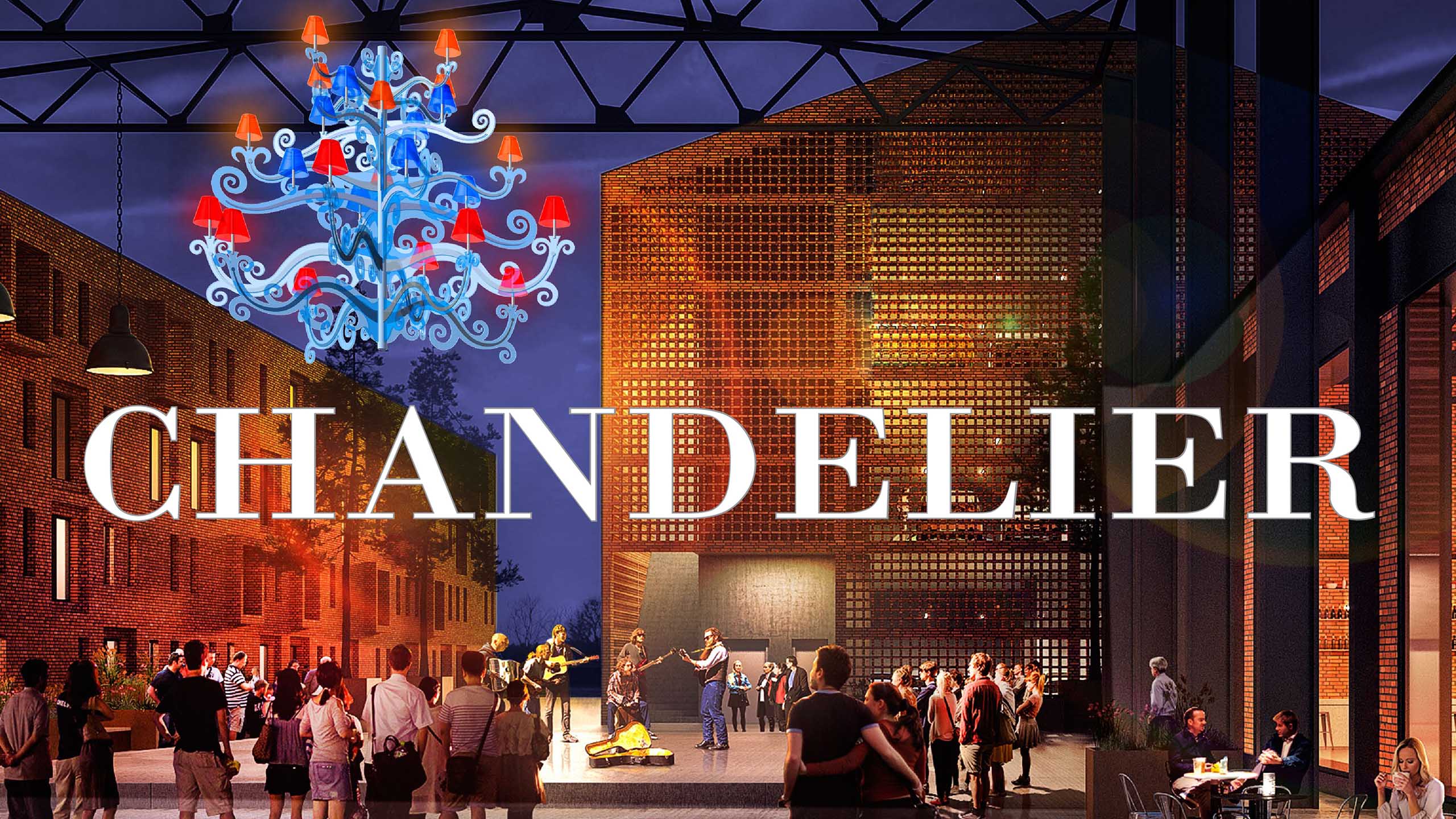
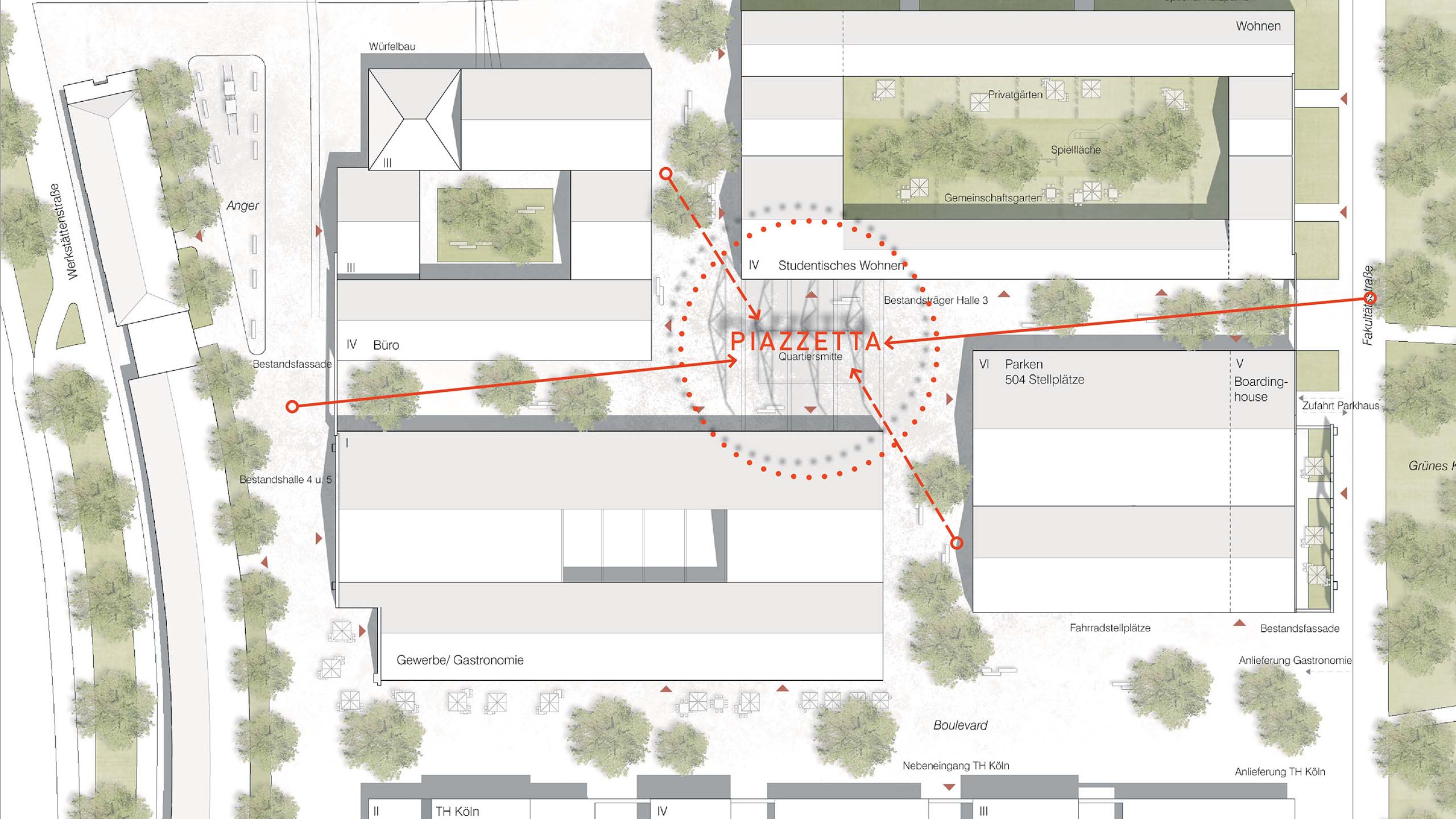
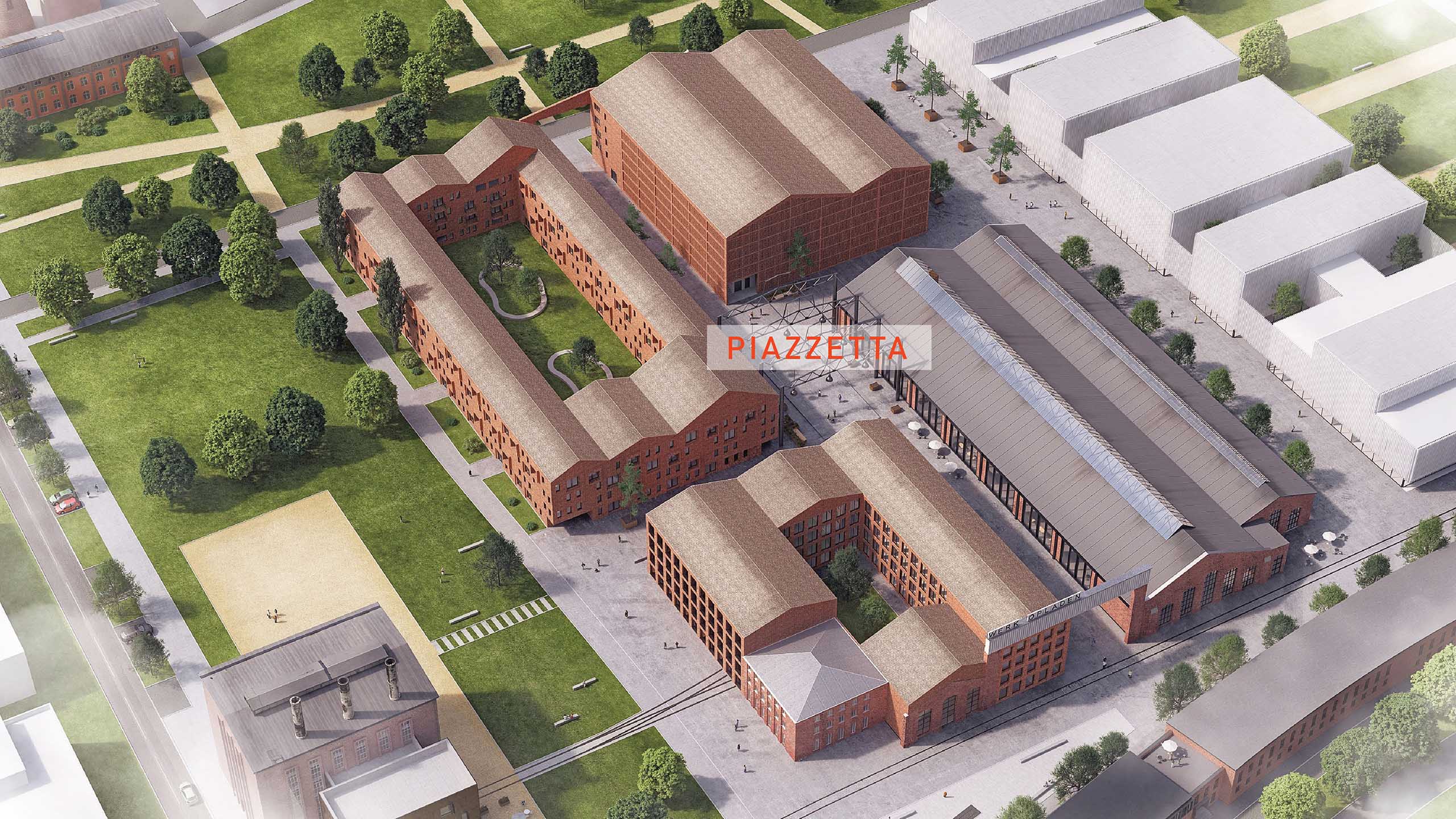
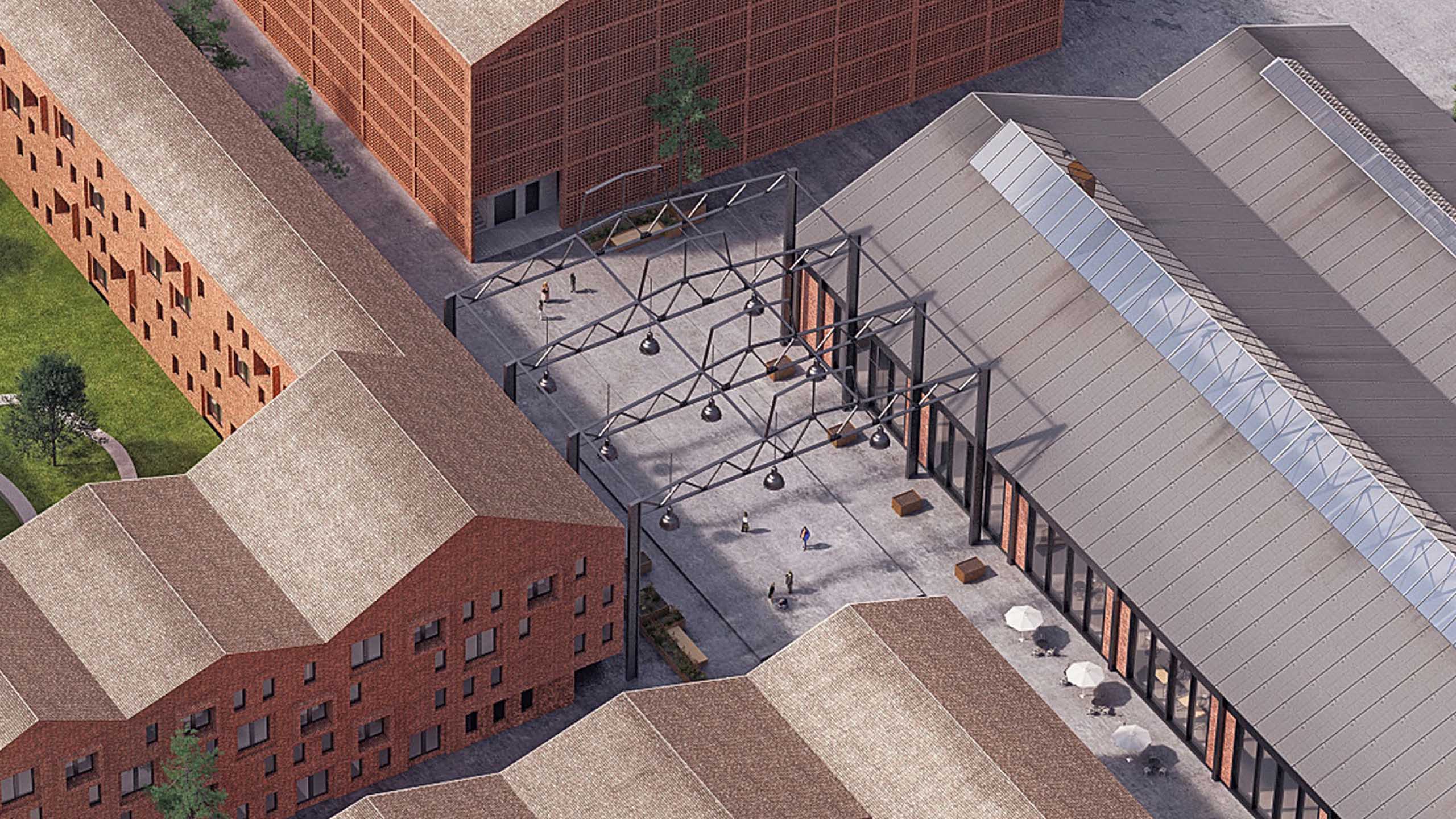
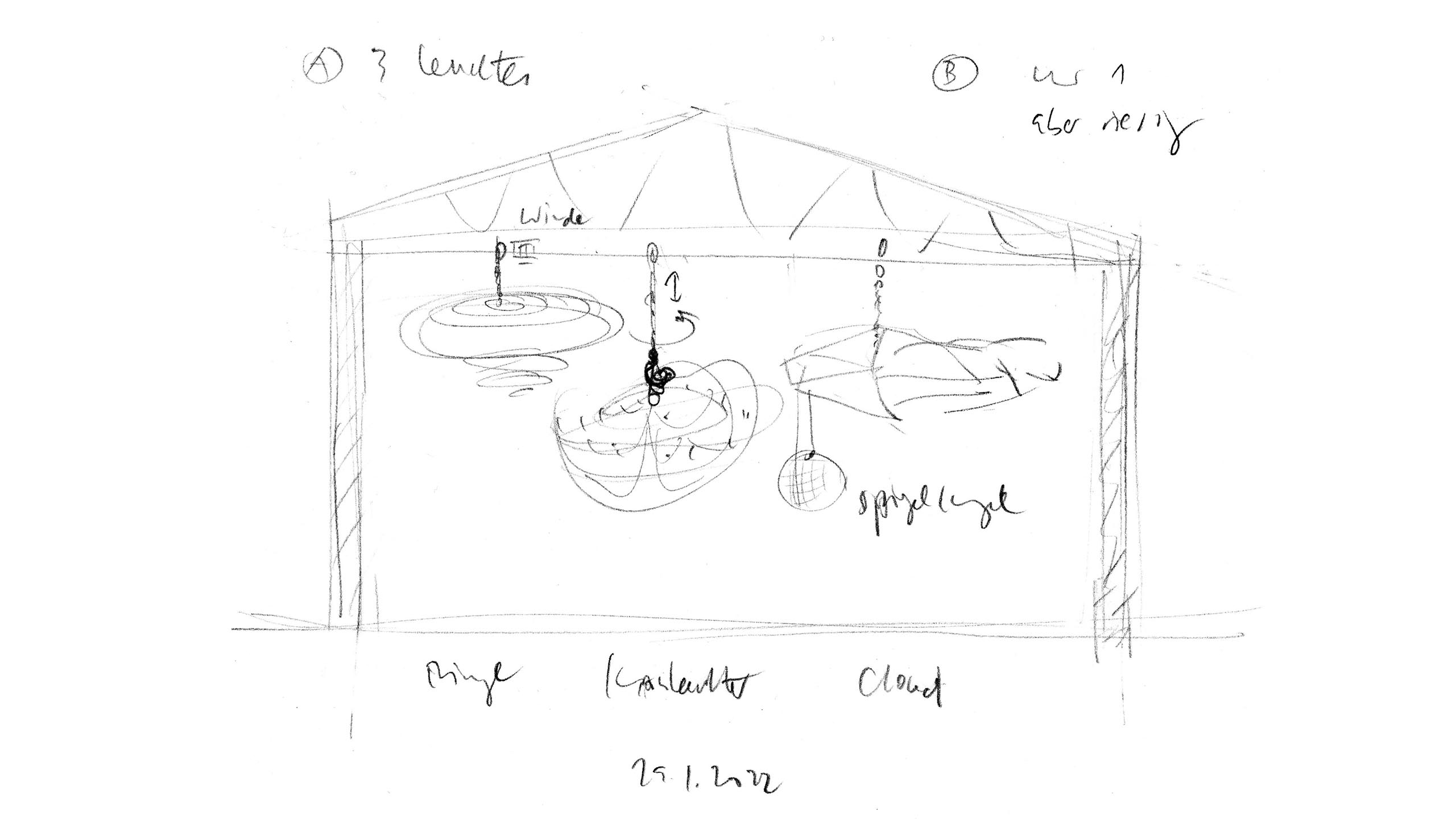
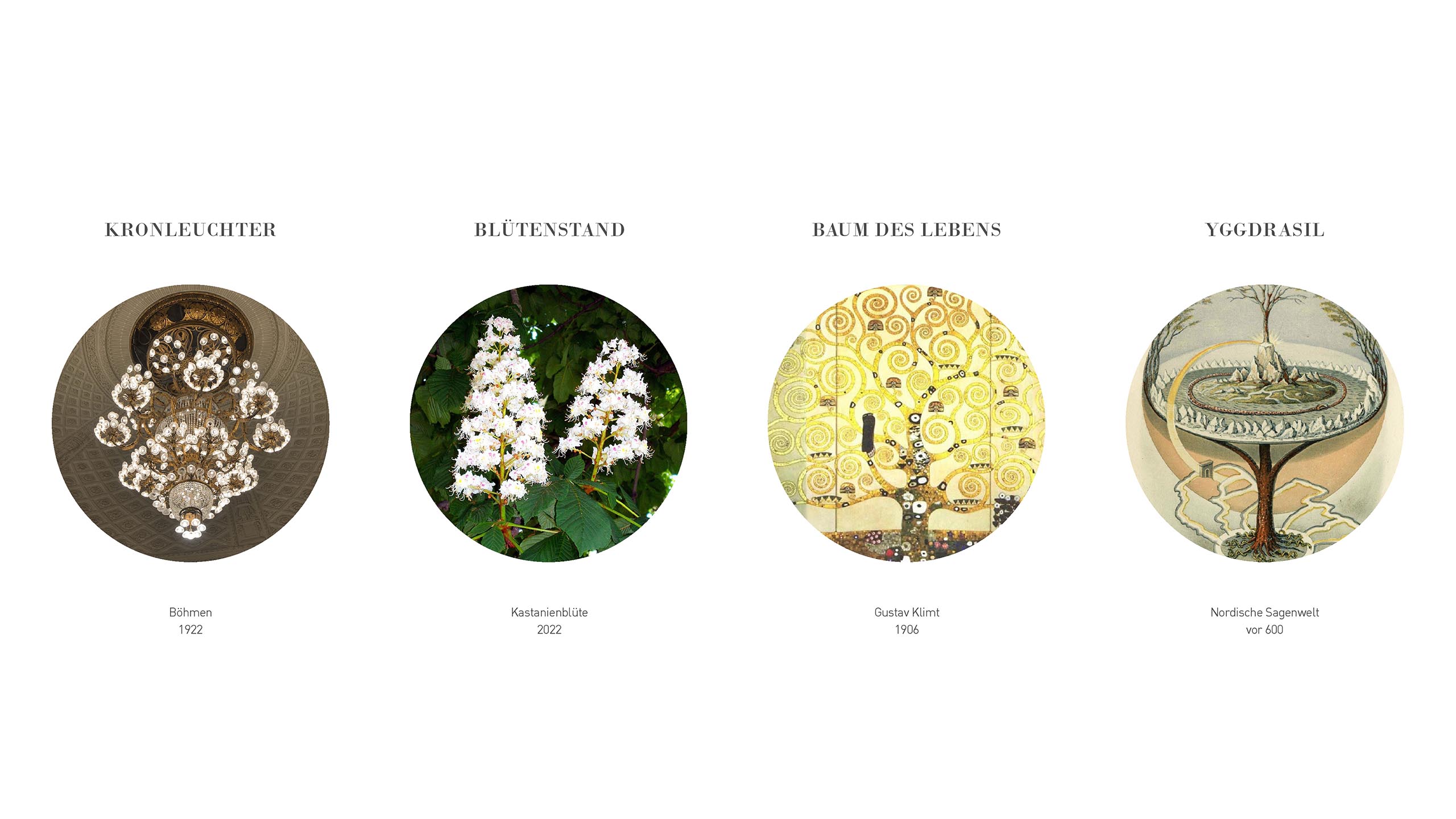
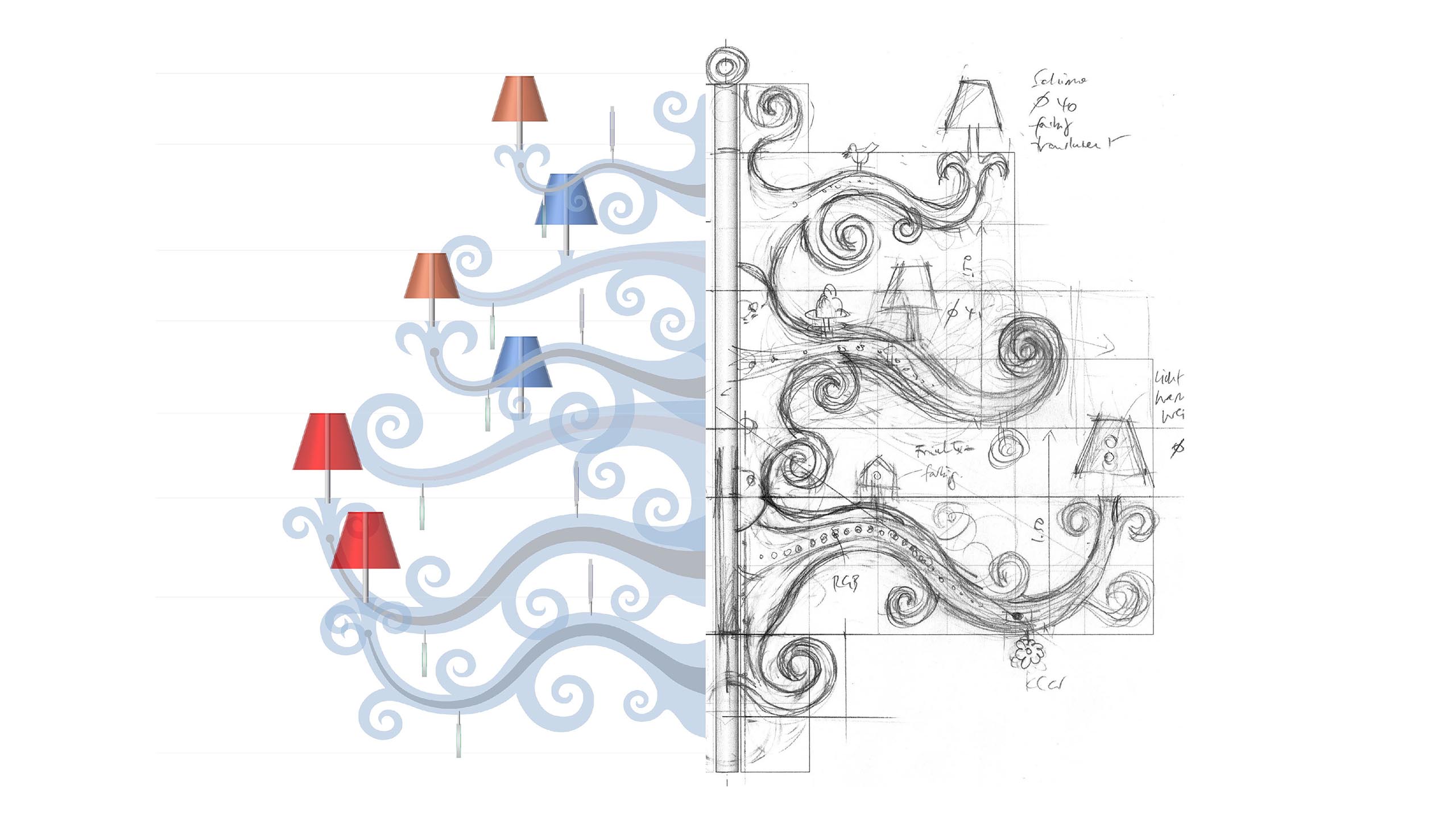
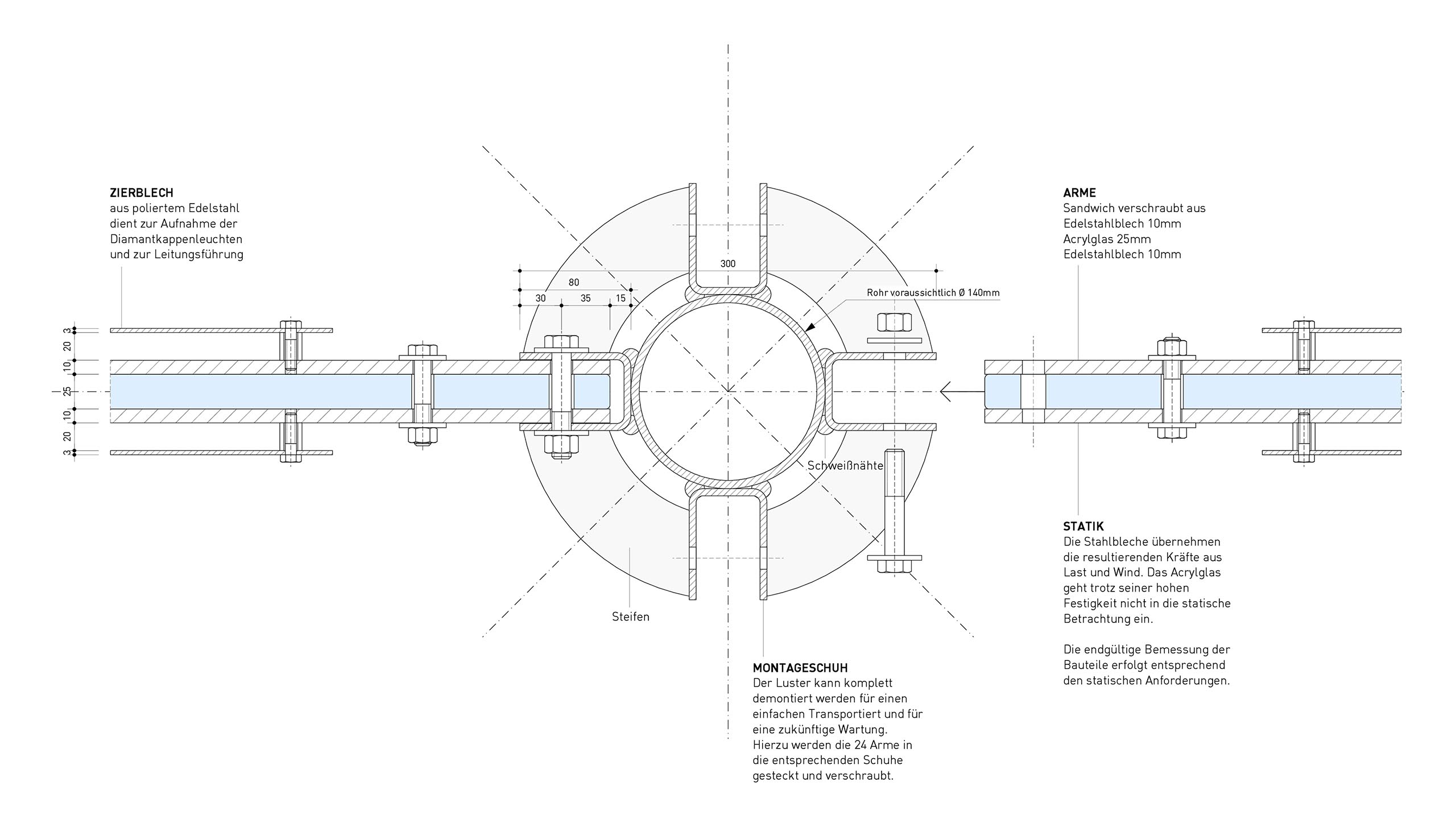
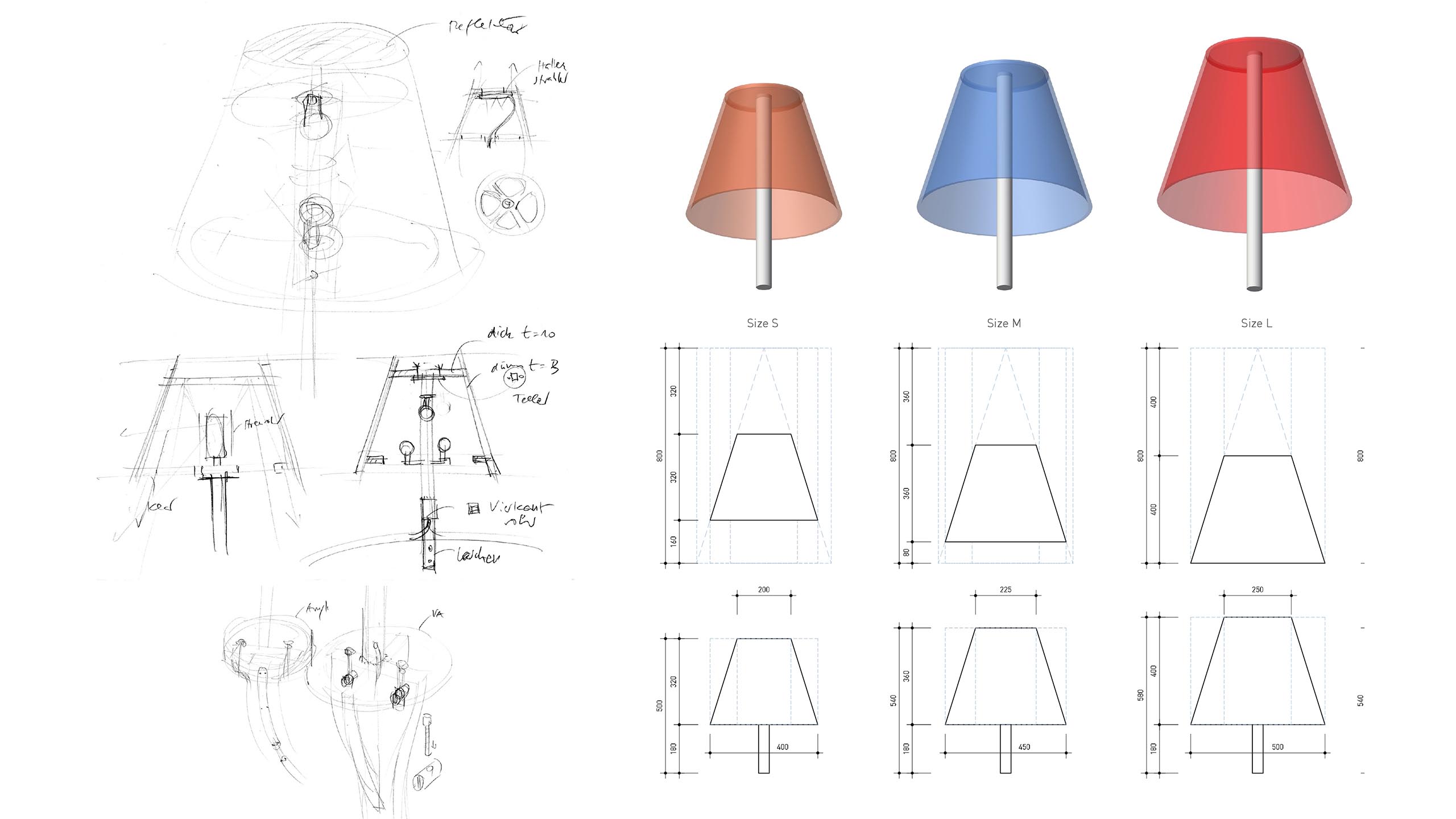
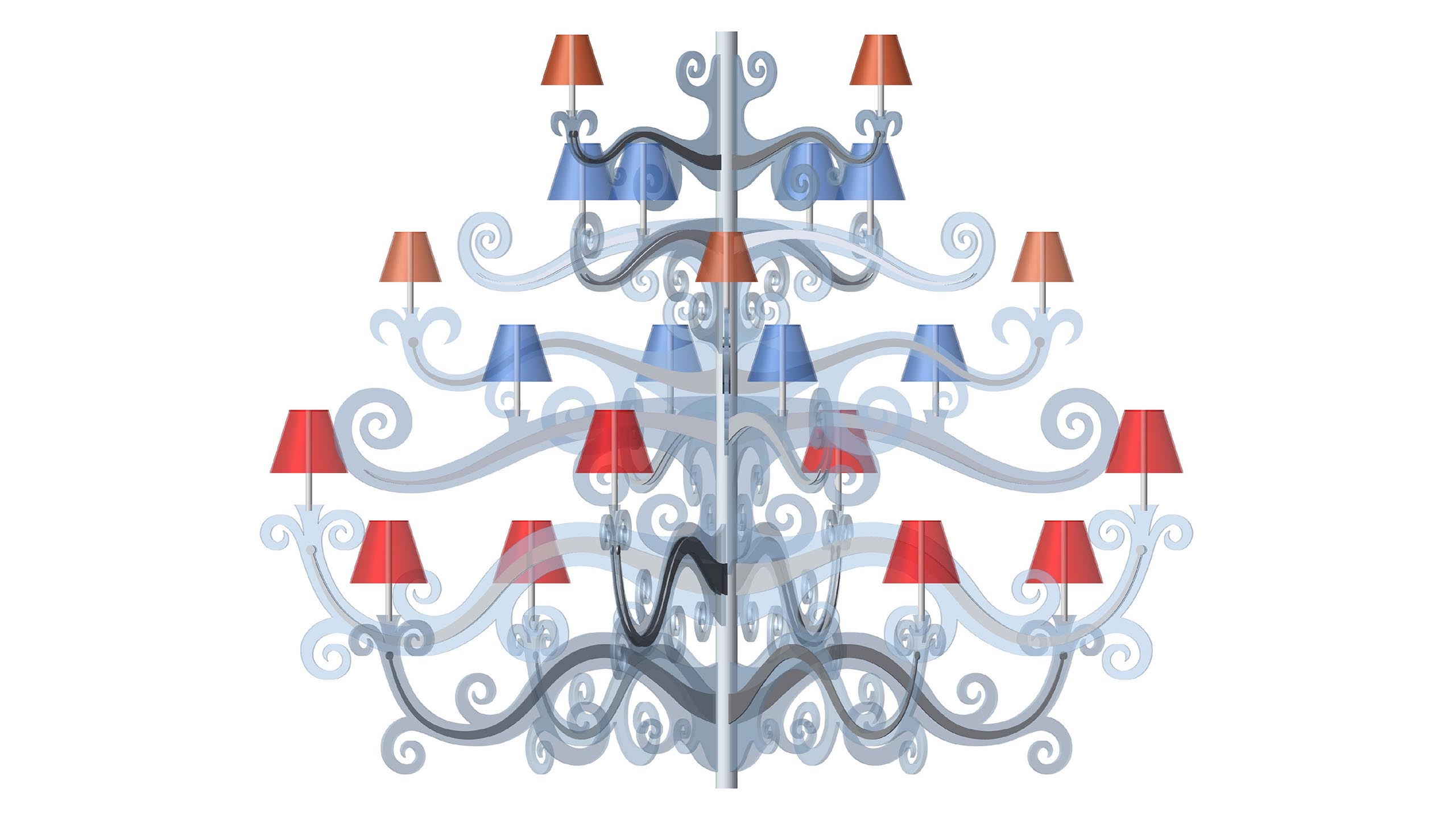
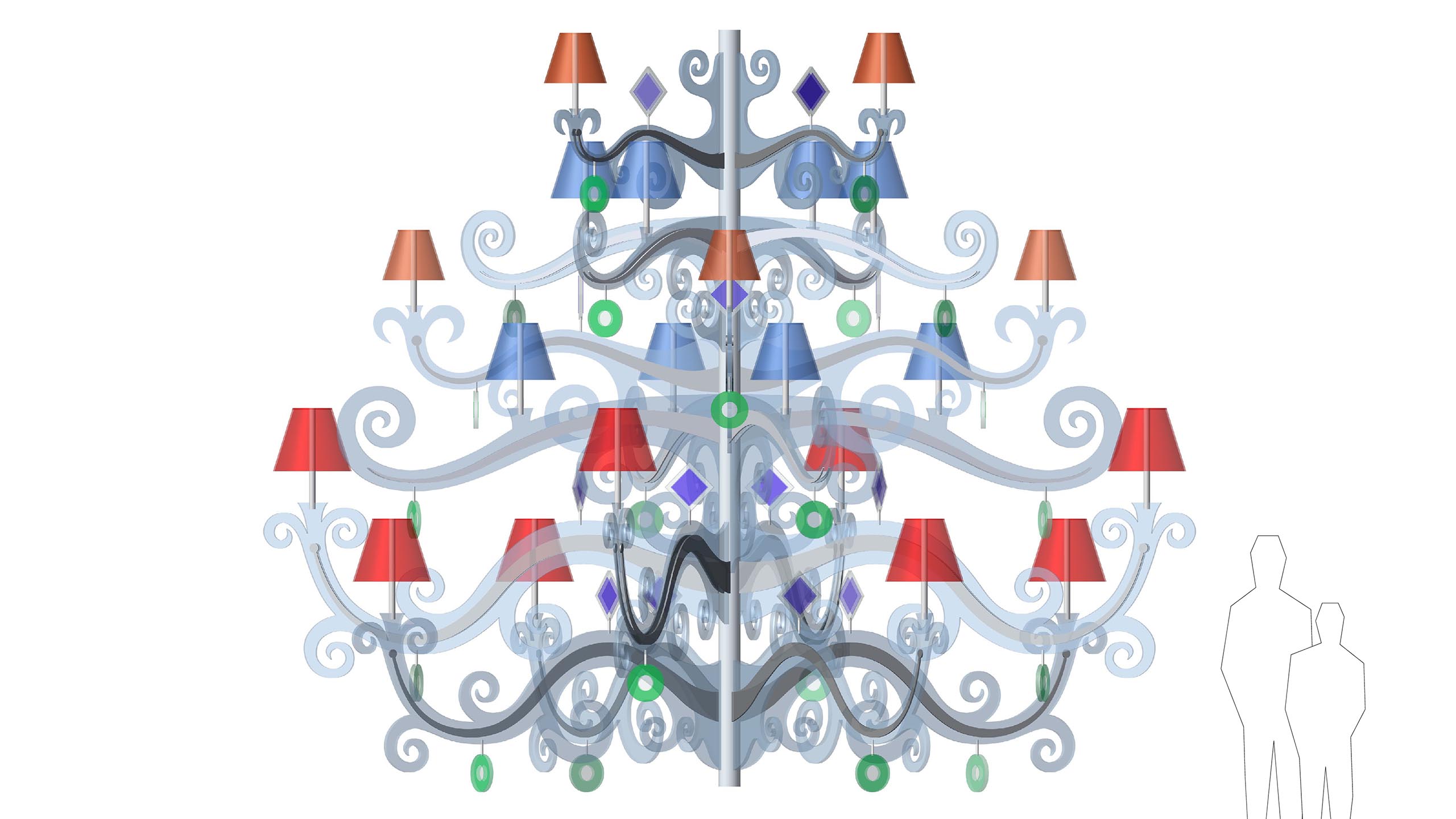
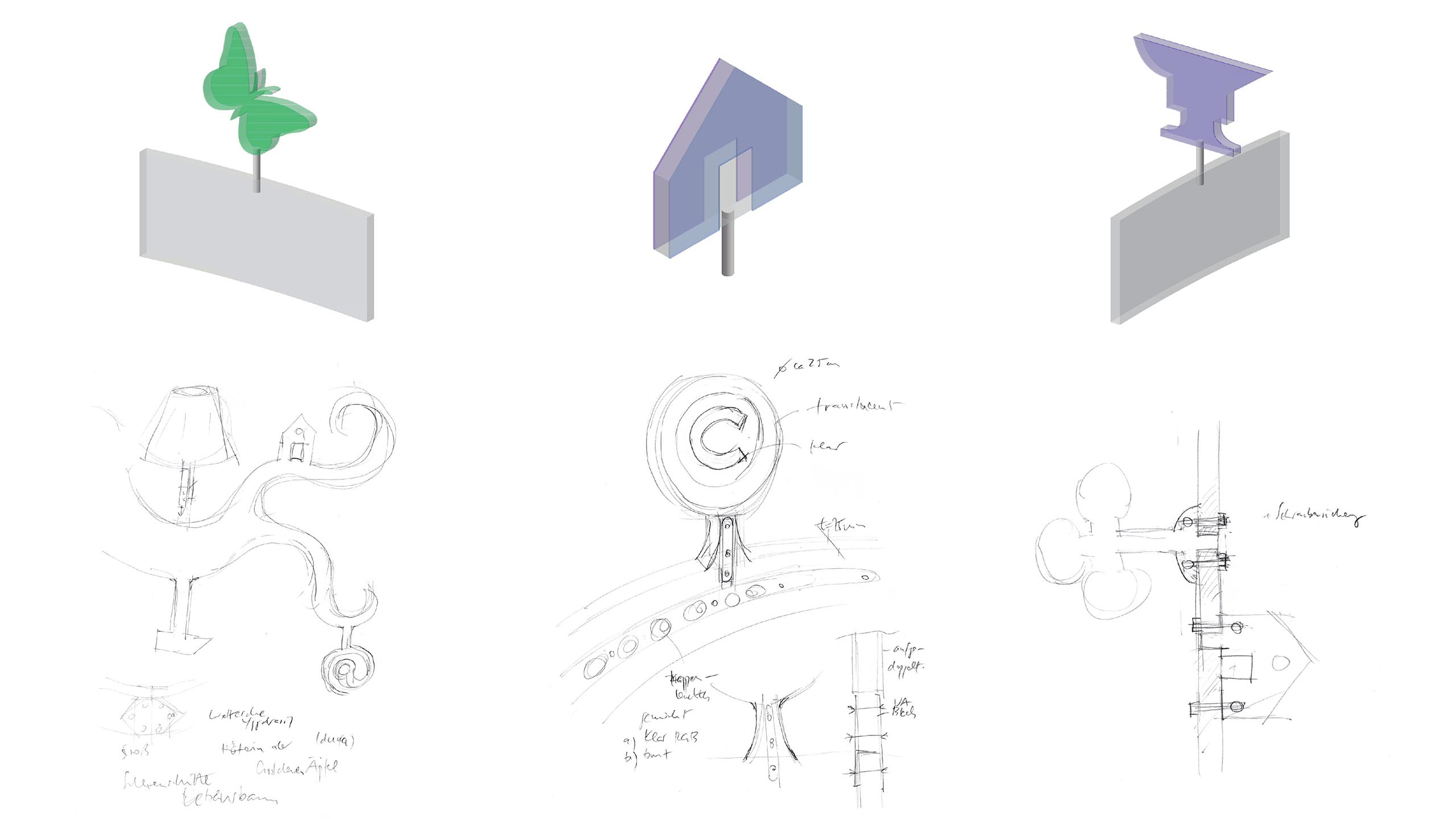
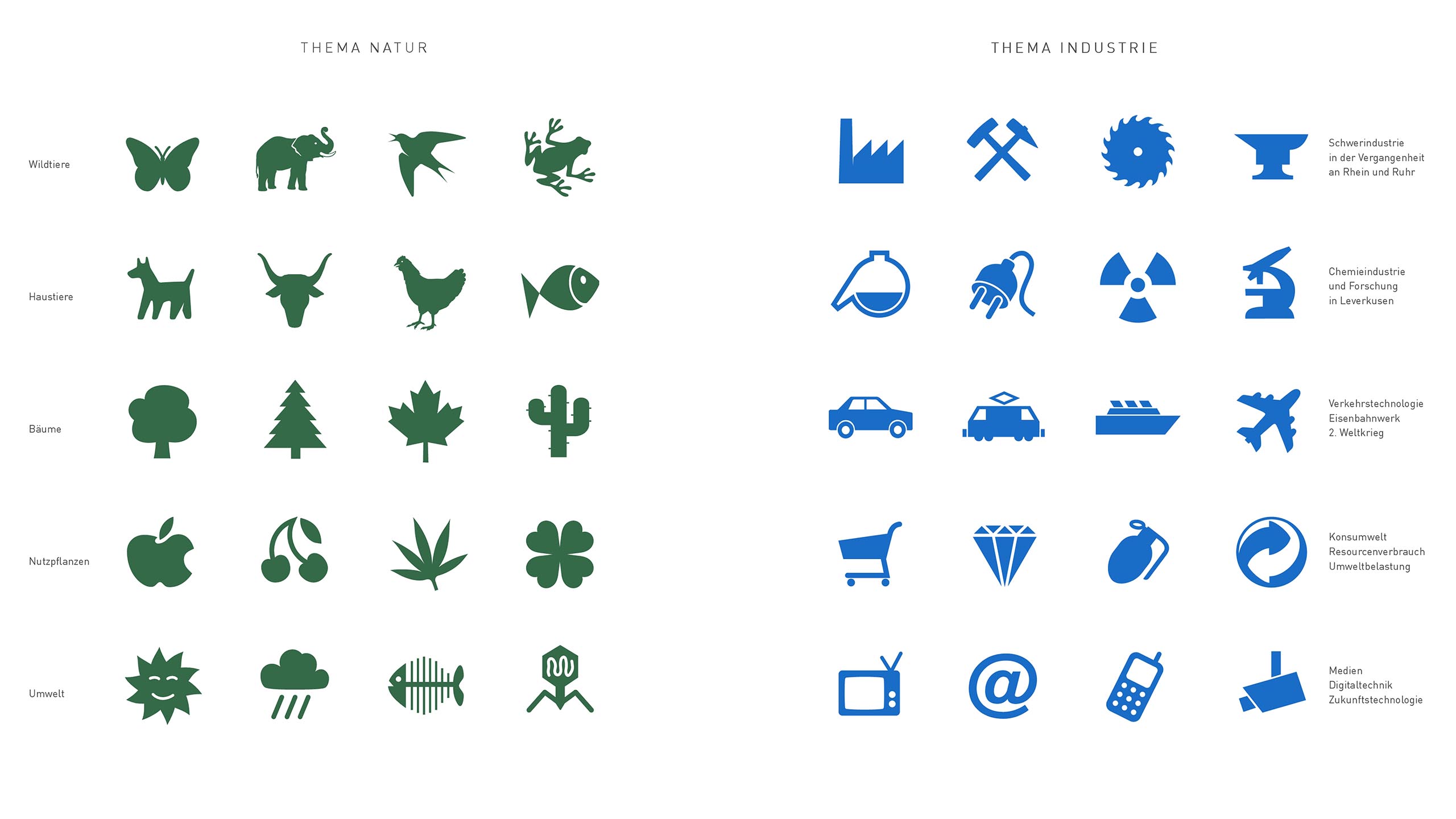
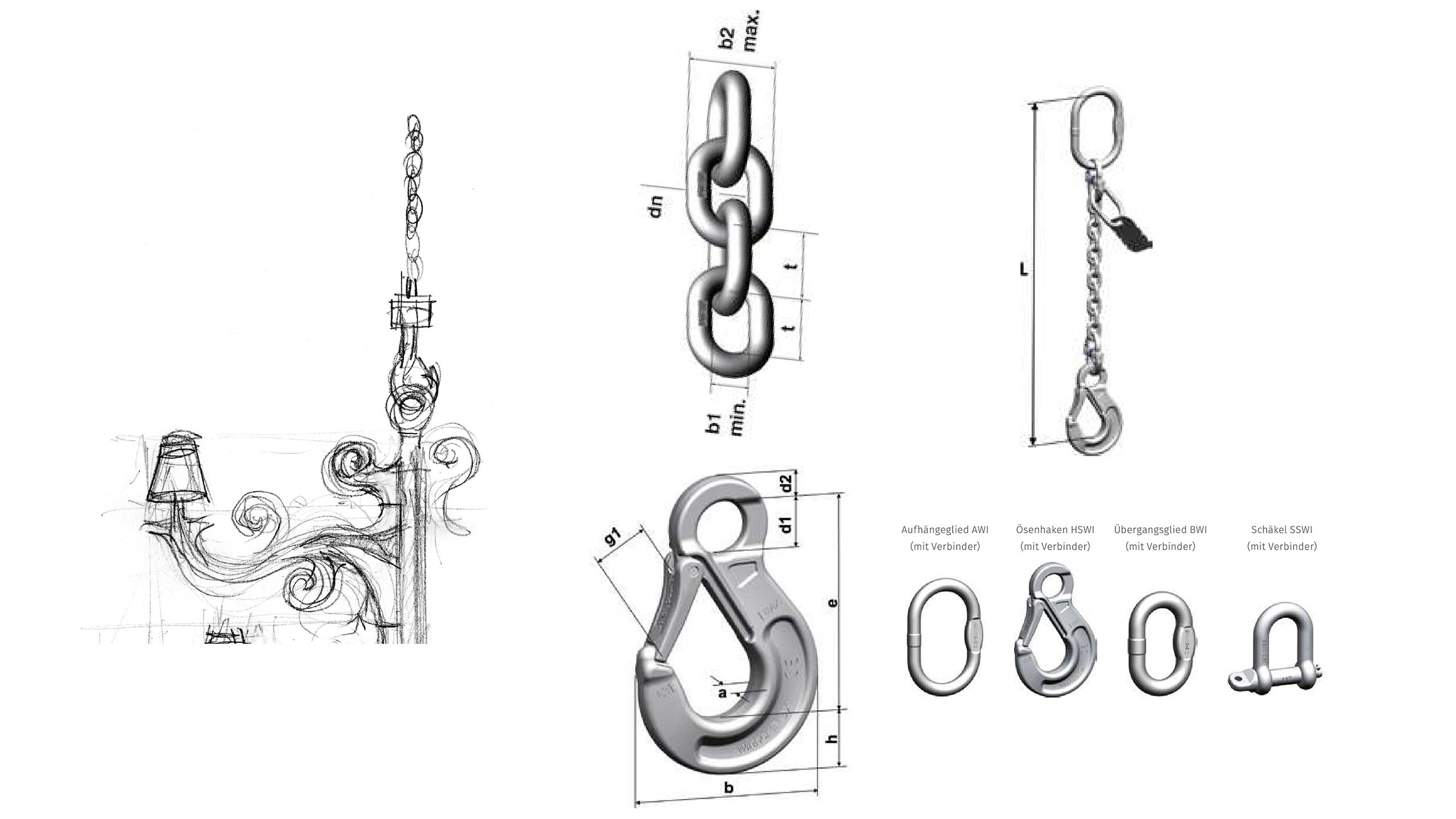
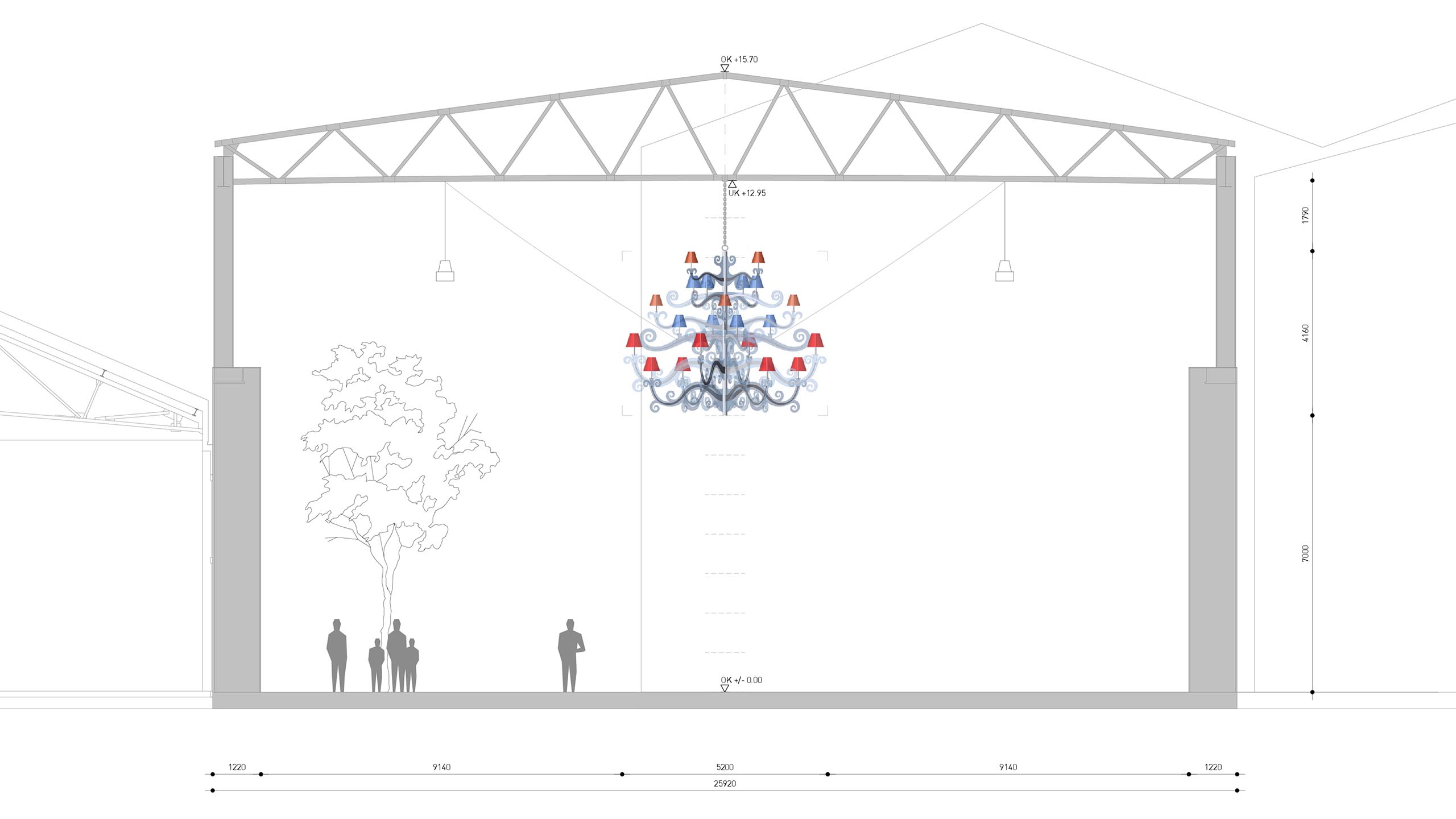
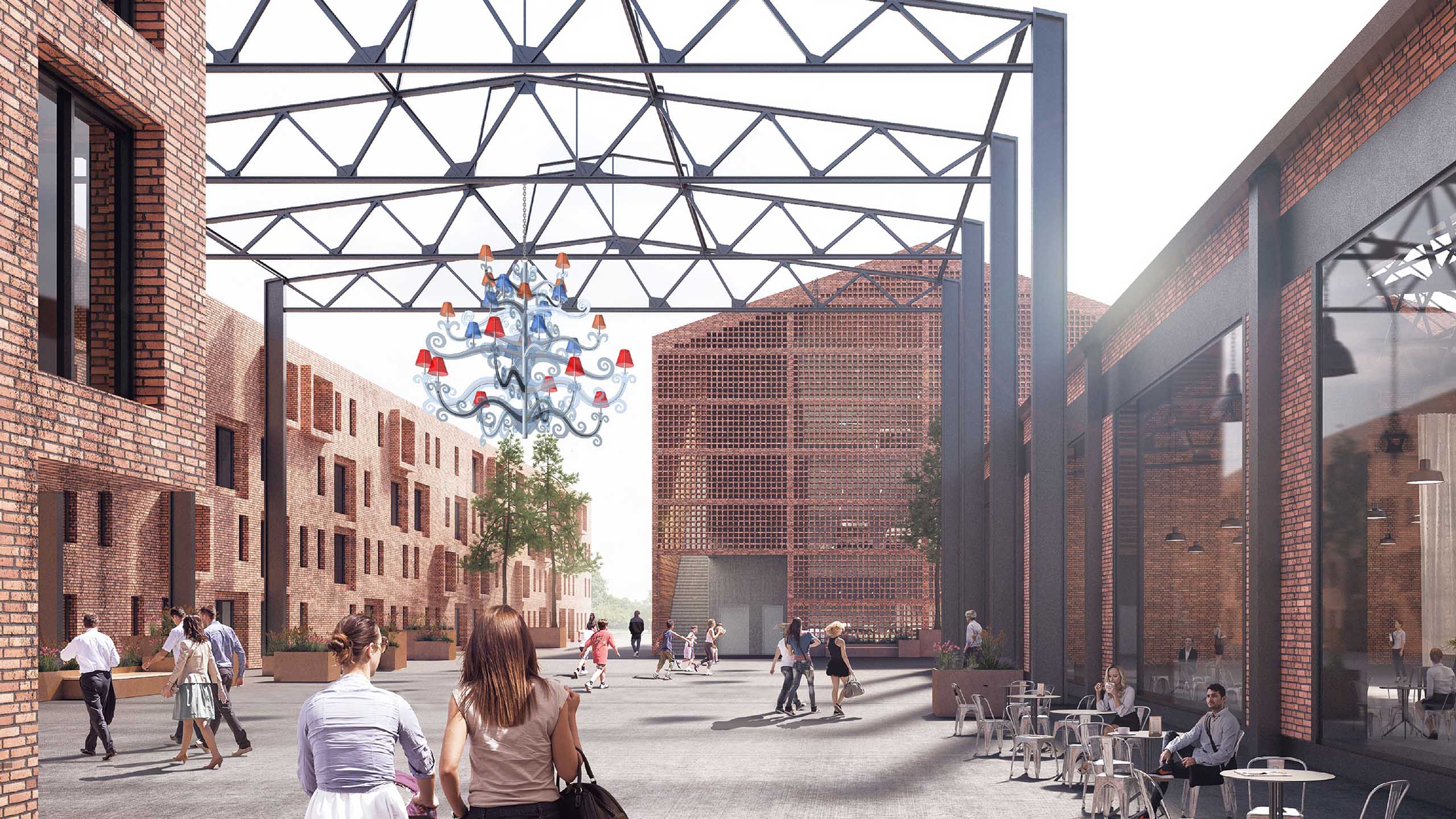
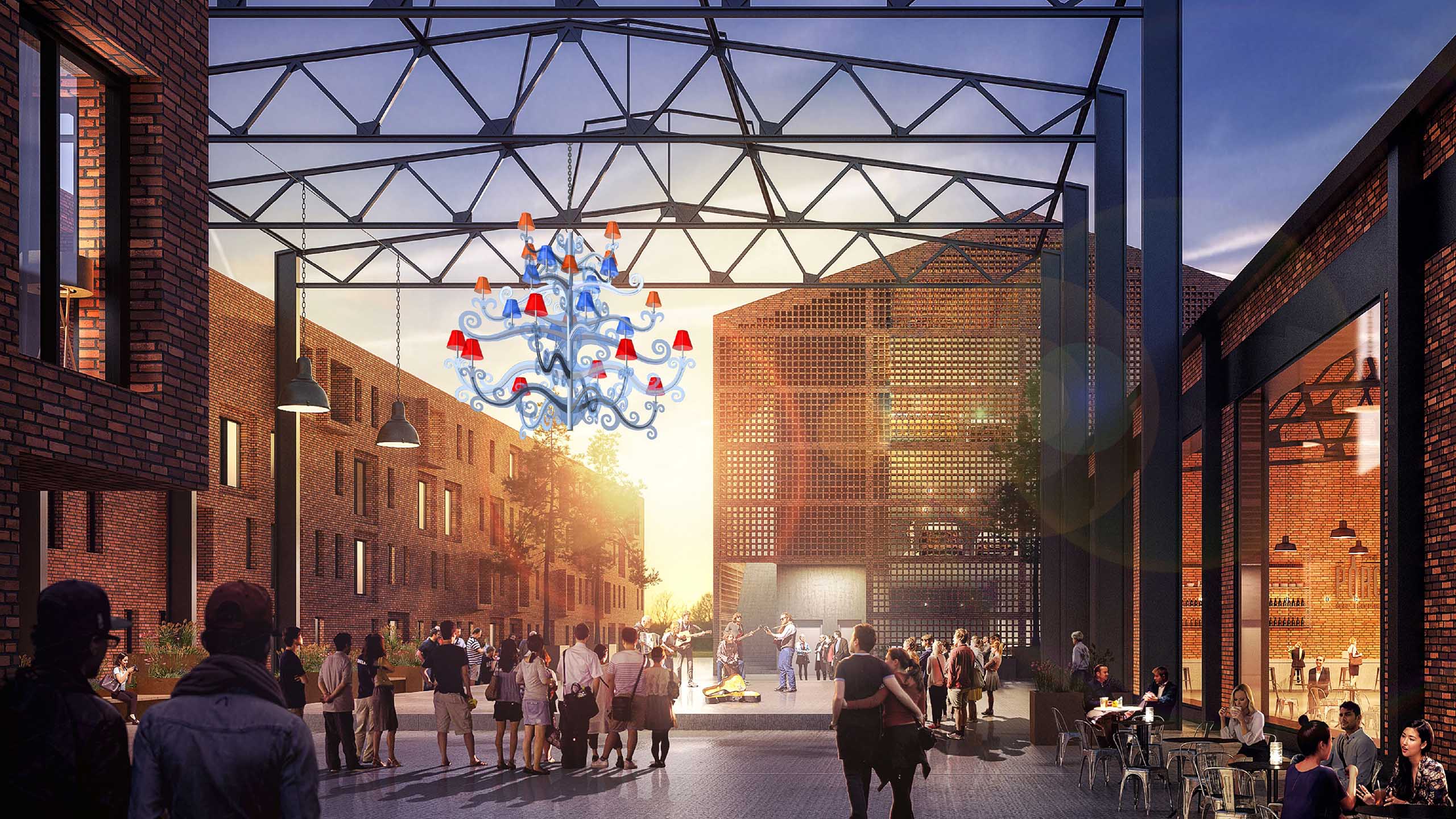
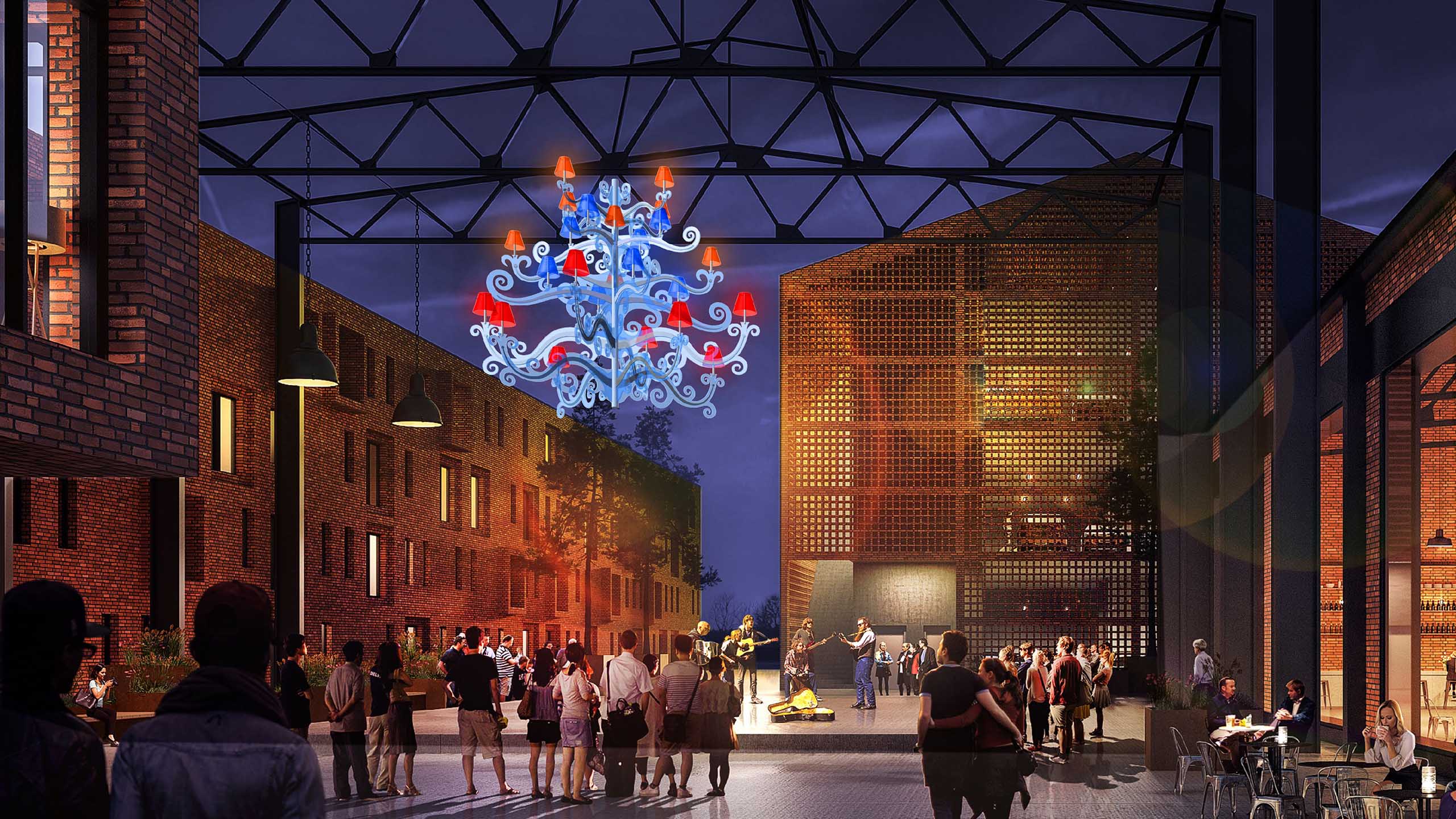
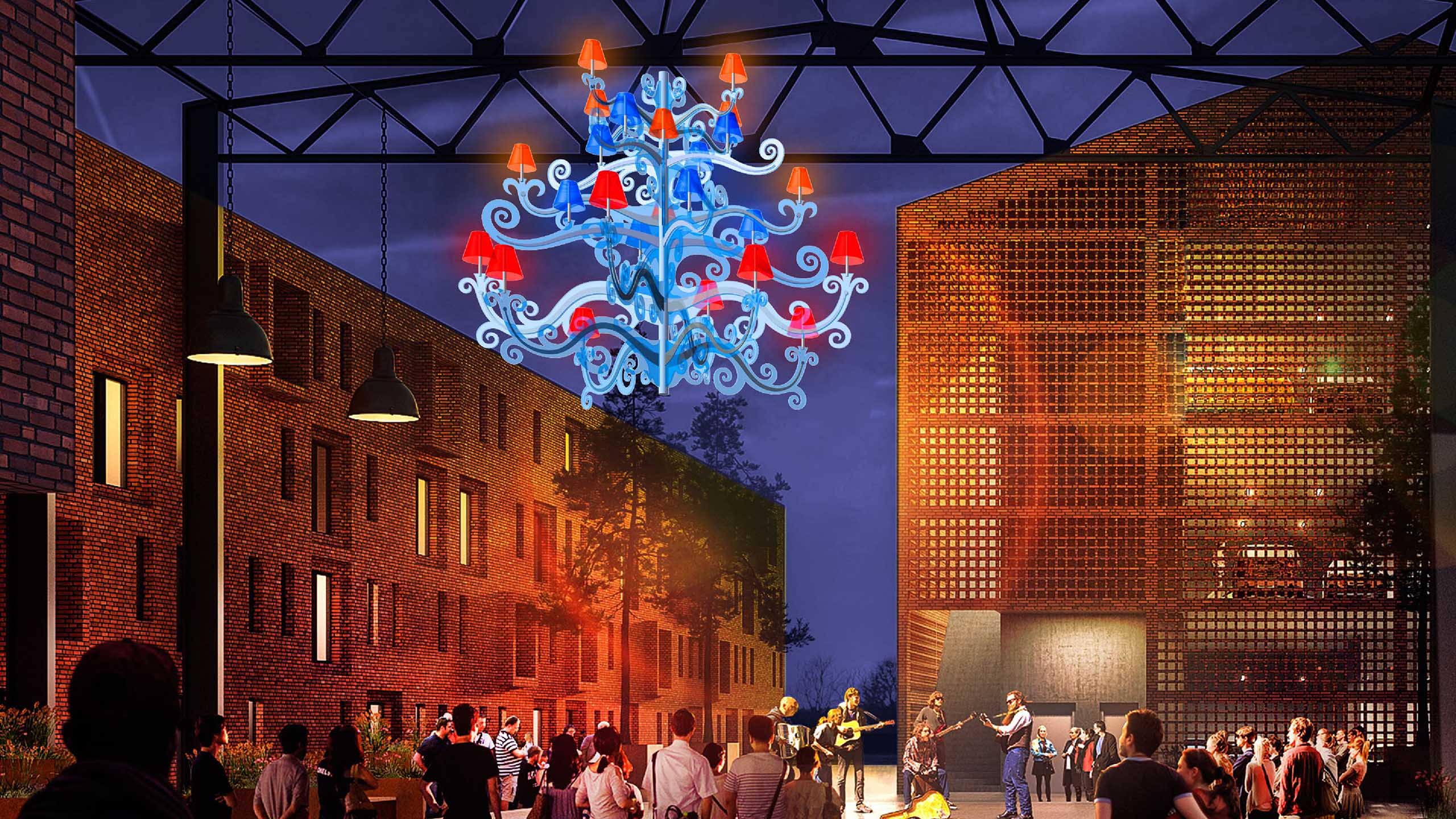
Ausgangspunkt meiner Überlegungen war das historische eindrucksvolle Industrieareal, das sich zu einem neuen Stadtteil wandelt, in dem gewohnt, gearbeitet und geforscht wird. Von der alten Bausubstanz bleibt nur Weniges, wie das Tragwerk einer gigantischen Produktionshalle, die als Reminiszenz an die Historie die neue Quartiersmitte bilden wird. Mein Entwurf CHANDELIER (englisch für Kronleuchter) baut auf dieser einmaligen Situation auf, geht mit ihr eine symbiotische Verbindung ein, hebt das volle Potential dieses sehr besonderen Ortes und bringt den neuen Platz im wahrsten Sinne zum Strahlen.
Warum ein riesiger Kronleuchter?
In den ehemaligen Werkhallen wurde im 19. Jahrhundert mit technischer Erfindungsgabe, enormen Fleiß und viel Schweiß ein ungeahnter Reichtum geschaffen, der das Fundament für die bürgerliche Kultur bildete. Diese manifestierte sich mit überbordender Pracht in reich geschmückten Wohngebäuden, Opernhäusern, Museen, Rathäusern und Städten, die wir auch heute noch lieben und gerne besuchen. In prächtigen Ballsälen, wie z.B. der historischen Stadthalle in Wuppertal, traf und vergnügte sich die „High Society“, deren ökonomische Grundlage die rauen Werkhallen waren, die hier an Rhein und Ruhr zu finden sind.
Mit einer großzügigen künstlerischen Geste werden nun beide Pole in einem surrealen Akt zusammengeführt. Ein riesiger opulenter Kronleuchter von über 5m Durchmesser lädt den Platz atmosphärisch auf und verwandelt ihn in einen Festsaal, der nun demokratisch allen Bürgern und Besuchern zugänglich ist: ob in der Mittagspause, für den Nachmittagskaffee, den Feierabenddrink, ein Geschäftsessen, ein Rendevouz oder zum gemeinsamen Feiern.
Das Kunstwerk ist sowohl sinnlich reizvoller ästhetischer Kontrast zur historischen Bebauung, wie tiefsinniger Kommentar zum Genius Loci. Die Gestaltung des CHANDELIER für Leverkusen geht aber über den konventionellen Kronleuchter weit hinaus:
In seinem Aufbau lehnt er sich an die üppigen Blütenkaskaden eines Kastanienbaums an, zitiert mit seinen spiraligen Armen den berühmten ‚Baum des Lebens‘ von Gustav Klimt und erweitert so auf künstlerische Weise das Spannungsfeld von Kultur und Technik um das Thema der Natur.
Statt der polierten Kristalle des traditionellen Lusters wachsen an den Armen bzw. Ästen etwa 40 piktogrammartige „Früchte“, die zu einer Hälfte auf das Tier- und Pflanzenreich verweisen und zur anderen Hälfte auf unserer modernen Technik- und Konsumwelt. In der mengenmäßigen Balance ist das Kunstwerk damit auch ein Bild für die Einheit von Mensch, Natur und Technik und ein ökologisch nachhaltiges Gleichgewicht.
Technischen Ausführung
Der Kronleuchter hat je 24 Arme und Leuchten, die den 24 Stunden des Tages entsprechen. Die insgesamt 6 gegeneinander versetzten Etagen haben einen Durchmesser von ca. 5,2m und eine Höhe von ca. 4,2m, bei einem Gesamtgewicht von ca. 850kg. Der Leuchter hängt mit seiner Unterkante in etwa 7m Höhe zentral über der Platzmitte. Der Platz selbst bleibt zum Befahren, für eine Bestuhlung oder für Veranstaltungen frei bespielbar. Auch die Aufhängung des Leuchters an einem schweren Kranhaken und einer massiven Edelstahlkette führt das künstlerische Thema fort.
Der CHANDELIER soll den ganzen Platz mit dimmbaren und energiesparenden LED-Licht in warmweißer Lichtfarbe beleuchten und kann so die bisher vorgesehene technische Beleuchtung durch Hallenstrahler ersetzen. Die farbige Erscheinung der Lichtskulptur – und damit auch die Platzatmosphäre – kann zudem frei steuerbar in den RGB-Farben verändert werden. Zum Beispiel für besondere Events oder um den Wochentag farbig zu markieren oder als optischer Gong um die vollen Stunde anzuzeigen.
Das Kunstwerk besteht hauptsächlich aus Acrylglas, Aluminium, Edelstahl und LED-Licht. Wegen der möglichen Windlasten wird es in allen 4 Himmelsrichtungen gegen Pendeln gesichert. Die Dimensionen aller wichtigen Bauteile werden selbstverständlich statisch berechnet und nachgewiesen.
//
The starting point for my considerations was the historically impressive industrial site, which is being transformed into a new district where people live, work and research. Only a few of the old buildings remain, such as the supporting structure of a gigantic production hall, which will form the new centre of the district as a reminder of history. My design CHANDELIER (English for chandelier) builds on this unique situation, enters into a symbiotic relationship with it, raises the full potential of this very special place and makes the new square shine in the truest sense.
Why a huge chandelier?
In the 19th century, technical ingenuity, enormous diligence and a lot of sweat created unimagined wealth in the former factory halls, which formed the foundation for bourgeois culture. This manifested itself with exuberant splendour in richly decorated residential buildings, opera houses, museums, town halls and cities that we still love and enjoy visiting today. In magnificent ballrooms, such as the historic Stadthalle in Wuppertal, the „high society“ met and enjoyed itself, whose economic basis was the rough factory halls that can be found here on the Rhine and Ruhr.
With a generous artistic gesture, both poles are now brought together in a surreal act. A huge opulent chandelier over 5m in diameter atmospherically charges the square and transforms it into a banqueting hall that is now democratically accessible to all citizens and visitors: whether for lunch, afternoon coffee, an after-work drink, a business lunch, a rendezvous or to celebrate together.
The artwork is both a sensually appealing aesthetic contrast to the historic buildings and a profound commentary on the genius loci. The design of the CHANDELIER for Leverkusen, however, goes far beyond the conventional chandelier:
In its structure, it borrows from the lush cascades of blossoms on a chestnut tree, quoting Gustav Klimt’s famous ‚Tree of Life‘ with its spiralling arms, thus artistically expanding the field of tension between culture and technology to include the theme of nature.
Instead of the polished crystals of the traditional chandelier, about 40 pictogram-like „fruits“ grow on the arms or branches, half of which refer to the animal and plant kingdoms and the other half to our modern world of technology and consumption. In its quantitative balance, the work of art is thus also an image of the unity of man, nature and technology and an ecologically sustainable equilibrium.
Technical design
The chandelier has 24 arms and lights each, corresponding to the 24 hours of the day. The total of 6 staggered tiers have a diameter of approx. 5.2m and a height of approx. 4.2m, with a total weight of approx. 850kg. The lower edge of the chandelier hangs about 7m above the centre of the square. The square itself remains free to be driven on, for seating or for events. The suspension of the chandelier from a heavy crane hook and a massive stainless steel chain also continues the artistic theme.
The CHANDELIER is to illuminate the entire square with dimmable and energy-saving LED light in a warm white light colour and can thus replace the technical lighting previously provided by hall spotlights. The coloured appearance of the light sculpture – and thus also the atmosphere of the square – can also be freely controlled in RGB colours. For example, for special events or to mark the day of the week in colour or as an optical gong to indicate the hour.
The artwork consists mainly of acrylic glass, aluminium, stainless steel and LED light. Because of the possible wind loads, it is secured against swinging in all 4 cardinal directions. The dimensions of all important components are of course statically calculated and verified.
P R O P O S A L Competition Quartiersmitte des Areals Cube Factory 577 Leverkusen 2022 + D E S I G N LED-light / acrylic panels/ aluminium / stainless steel / digital control / size + S U P P O R T Kunst Raum Konzepte, Dirk Monreal, Anke Niemeyer Munsteiner Werbetechnik, Holger Glettenberg Hebezeuge Glettenberg, Peter Adler + M E D I A 20 images © Christoph Hildebrand + T A G S Light / Proposal / Urban / +
